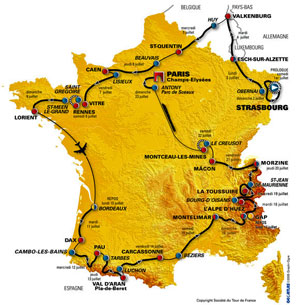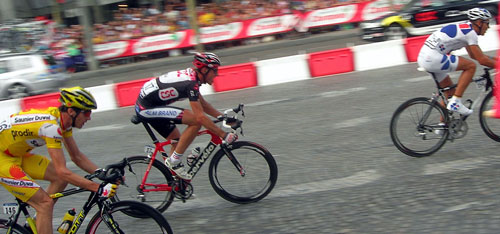A. The world’s premier cycling road race.
B. A three week long commercial for French tourism; or
C. The cause of a lot of late nights and early mornings for fans around the world.
The answer is of course D. All of the above.
The Tour de France (pronounced at all times “Tour de FRONCE”, to rhyme with… er… “wants”, rather than with “lance”) has been going since 1903 and is easily the most famous and prestigious cycling event in the world. Part of this is the drama, of the greatest cyclists in the world pushing their bodies to breaking point to eke out even a 1 second gap in a day that stretches over a couple of hundred kilometres and up and down mountains, and repeating this for 3 weeks, a feat of endurance that leads to men like Lance Armstrong, Miguel Indurain and Eddy Merckx being worldwide household names in their times despite cycling’s relatively low profile as a sport. Part of this is the backdrop: fields of sunflowers, forests, winding mountain roads, picturesque French villages and grand medieval chateaus and castles which look straight out of the Three Musketeers. And part of this is the passion of the fans. Each stage (generally around 150-200km) will be lined almost end to end with fans (and banked up deep around the finish and other key points), clapping, cheering, waving flags and banners and generally being part of the ambiance of the race. These fans come not just from France but from all over the world to stand by one spot in the road while the cyclists come past.
To understand the way the Tour works, it is important to understand one physical phenomenon: slipstreaming. In short, it is easier and less tiring to go faster if you are behind another cyclist, even better if you are behind multiple other cyclists. Thus in each stage the main body of cyclists will be in a mass peloton, with leading teams taking turns to burn energy to set the pace up the front (if it suits that team to do so), and the question is always- when is the right time to break away and try to outrun the peloton? The longer you are out of the peloton, the more effort you need to put in just to stay at the same speed as the peloton (let along go faster!). While people commonly break away in groups, a rider will still use more effort within a group of 5 than a group of 50 even without taking into account the likelihood that a rider in a group of 5 will have to spend some time leading that 5.
This is also the reason Tour cycling is a team game, even though the prizes are mostly individual. It’s much easier to break away and gain time on your rivals when you have teammates who can go with you and give you a bit of a slipstream for as long as they can hold out.
The other important rule, due to the peloton, is that if a group of people cross the line with no gap between riders greater than one second, the entire group are counted as having crossed at the same time as the first member of the group. As such, apart from the small number of top sprinters at the front, there’s no pressure on groups crossing the line to jockey for position amongst themselves and risk crashes.

Speaking of the prizes, the one everyone knows is the iconic Yellow Jersey (or “maillot jeune” if you a commentator or similar person who feels the need to practice their French accent at every opportunity), which is worn by the leading overall rider. It is often dominated for years at a time by a single rider, such as Lance Armstrong. In practice, the Yellow Jersey is dominated by the riders who are strongest in the mountains, who inevitably lose much less time to the sprinters on flat stages than the sprinters lose on steep mountain stages. This year, several main contenders for the Yellow Jersey have crashed out or lost significant amounts of time to crashes (including 3-time champion Alberto Contador and former Olympic champion Bradley Wiggins), and the main contenders appear to be Cadel Evans of Australia, Frank and Andy Schleck of Luxembourg, and Ivan Basso of Italy, who remain within a few seconds of each other (yes, a few seconds, after two weeks of racing). At time of writing the actual jersey is held by Frenchman Thomas Voekler, who grabbed the jersey in a stunning breakaway with the assistance of confusion caused in the peloton by a major crash, but while Voekler kept the jersey on Bastille Day and lost only a little time on the first major mountain stage, he is expected to be out of the jersey by the time you read this.
Speaking of the Schleck brothers, their team is Leopard Trek. They insist the commentators pronounce it “LAY-o-pard Trek”, much to the annoyance of all English-speaking viewers who have undoubtedly exclaimed at least once “It’s $@#$%@#$ LEOPARD. LEP. ARD. The French didn’t invent leopards!” (although they did invent the word leopard, so shut up, English-speaking viewer, and don’t swear so @#$@!#$@~ much).
The Green Jersey is the sprinters’ prize. Each stage awards points to the first few riders past an intermediate point (generally close to half-way) and to finish the stage. Breakaways, mass sprint finishes and tiny margins are the order of the day for this prize. Mark Cavendish of the UK currently leads the Green Jersey race, a man who has won 18 Tour de France stages in his career (the most of any current rider) and who has a highly trained team dedicated to giving him the best possible run at every sprint he wants to contest. The other big contender is Phillipe Gilbert of Belgium, who can’t match Cavendish for pure sprinting but is better in hillier terrain and so often finds himself in a position to go for sprints which Cavendish and other pure sprinters can’t get to.
A polka-dotted jersey marks the King of the Mountains. All designated climbs have points. Like with sprints, first over the line gets maximum points and a limited number of places after that also get points. The amount of points, and how far down the places gets points, depends on the magnitude of the climb.
The King of the Mountains jersey was involved in a rare and terrible incident in this year’s race. Johnny Hoogerland had just taken the lead in King of the Mountains and was part of the tremendous breakaway that delivered the Yellow Jersey to Thomas Voekler when he and another rider in the break were struck by a swerving television car and went tumbling through a barbed wire fence.
Both felled riders were able to limp in to the finish and continue with the race (taking advantage of the fact that the next day was the scheduled rest day), and Hoogerland in particular has become one of the fan-favourites of the Tour because of his courage in continuing the approximately 50km to the line with wounds which required 33 stitches.
Many riders are in the Tour seeking not one of the jerseys for a great overall performance, but a single stage win. These riders can afford to use everything they have to cross the line first on their chosen stage, knowing that unlike the best riders, it doesn’t matter if they’re at the back of the pack for a couple of days while their strength returns. While these breakaway riders will only win a few stages per Tour between them, they will also get plenty of TV time for their sponsors while they are up the front (and for some of them, that TV exposure itself is the main reason to go out on a breakaway).
And of course, a great many riders in the tour are not there for any personal glory at all. They are there as pacemakers, shields, water carriers and all-round support for their team leaders. It is not until you actually watch the tour that you realise how much the individual glories rely on the hard work of these unsung teammates.

The race has now reached a critical point- the riders are in the Pyrenees, and then go to the Alps. These are the stages where the contenders shake out and we see who can keep enduring climb after climb while others begin to slow down and fall away. After the Alps, there is a one-off individual time trial (no teams, no pelotons, just single riders and the clock: the last chance for the best individual riders to overtake their rivals), followed by the riders flying to Paris for the final stage, ending in a sprint on the Champs Elysees. By tradition, whoever holds the yellow jersey going into the final stage is allowed to win without trouble, and no attempts will be made to beat him- but if the Green Jersey is still up for grabs, the final sprint can have the epic drama to go with the epic visuals of the French capital’s most glorious avenue!
If you get a chance, give Le Tour a try, you’ll be glad you did.
Check your local listings and be sure to look for a high-definition channel because that’s really the only sensible way to watch.
